-
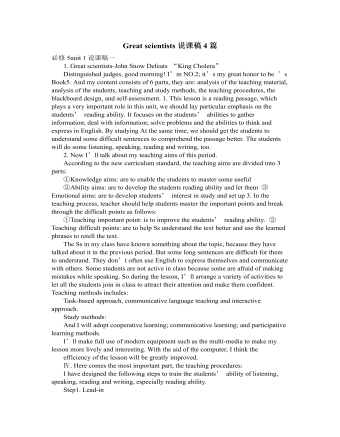
人教版高中英语必修5Great scientists说课稿4篇
通过写文章梗概,培养学生综合运用语言的能力,学习用恰当的英语描述科学家的故事。这是本课的教学难点。教师可以使用完形填空的方式来帮助学生整理语篇,从而来降低难度。本课的教学重点的突破方法是:在阅读前,让学生初步了解得出科学观点所需要的基本程序,从而轻松而自然地导入文章的阅读;在阅读过程中,由易到难设计快速阅读和精读的问题,层层推进各种阅读活动,让学生对阅读内容从整体感知到细节理解,最后深层读懂整篇文章,同时加强阅读策略的指导,让每个学生都主动参与课堂教学活动,最终达到提高阅读能力的目的。Step 4 Post-readingGroup Activities四人小组共同合作,在老师的适当指导下,就以下2个问题展开讨论,让学生就所知、所学、所感和所想融入话题,然后抽若干同学代表作小组发言。1. What do you think about John Snow, and what should we learn from him?2. Cholera was 19th century disease, which two diseases are similar to cholera today? Why?
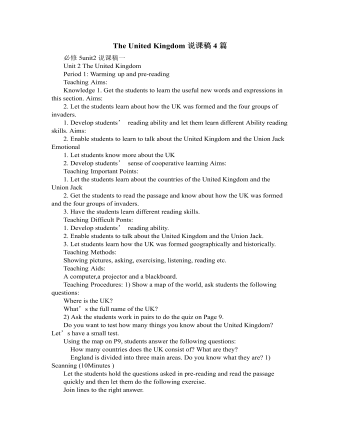
人教版高中英语必修5The United Kingdom说课稿4篇
Teaching Aims:Knowledge 1. Get the students to learn the useful new words and expressions in this section. Aims:2. Let the students learn about how the UK was formed and the four groups of invaders.1. Develop students’ reading ability and let them learn different Ability reading skills. Aims:2. Enable students to learn to talk about the United Kingdom and the Union Jack Emotional 1. Let students know more about the UK2. Develop students’ sense of cooperative learning Aims:Teaching Important Points:1. Let the students learn about the countries of the United Kingdom and the Union Jack2. Get the students to read the passage and know about how the UK was formed and the four groups of invaders.3. Have the students learn different reading skills.Teaching Difficult Ponts:1. Develop students’ reading ability.2. Enable students to talk about the United Kingdom and the Union Jack.3. Let students learn how the UK was formed geographically and historically.Teaching Methods:Showing pictures, asking, exercising, listening, reading etc.Teaching Aids:A computer,a projector and a blackboard.Teaching Procedures: 1) Show a map of the world, ask students the following questions:Where is the UK?What’s the full name of the UK?2) Ask the students work in pairs to do the quiz on Page 9.Do you want to test how many things you know about the United Kingdom? Let’s have a small test.Using the map on P9, students answer the following questions:?How many countries does the UK consist of? What are they??England is divided into three main areas. Do you know what they are? 1) Scanning (10Minutes )Let the students hold the questions asked in pre-reading and read the passagequickly and then let them do the following exercise.Join lines to the right answer.

人教版高中地理必修2煤城焦作出路何在说课稿
分析过焦作市的地理概况和产业优势后,就需要针对由于资源枯竭所带来的问题提出合理化的建议。既然是谈经济转型,就应该将话题的范围明确在这一领域内。通过材料3的相关内容,我们了解到焦作市需要在产业结构调整、培育新的优势产业、增强综合竞争力等三个整改方针上下功夫。因而引导学生针对优势与不足提出建议,以三个整改方针为基准,衡量建议的可行性是锻炼学生解决此类问题的有效途径。在此我将教会学生的是解决问题方法而非案例的内容,正所谓“授之以鱼,不如授之以渔”。接下来针对学生的建议和教材资料分析所罗列的10点整改思路,由学生自由发言提出看法,通过教师的指导和学生的讨论,进而确定经济转型建议的具体方案。最后注意将建议与产业优势相对照,看建议是否都是围绕着产业优势而提出的,这样做会加深学生的印象,通过建议和优势的对应关系,将不难找出此类问题的解题思路。
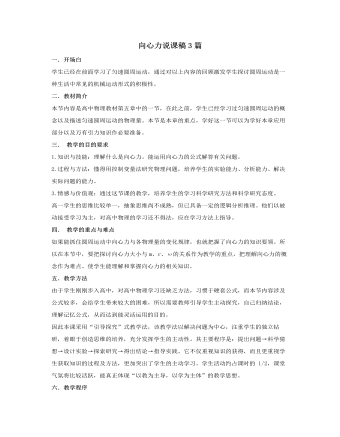
人教版新课标高中物理必修2向心力说课稿3篇
通过这个示例呢,我们可以得到解决向心力问题的一般的步骤,确定对象,找出轨迹,找出圆心,然后进行受力分析,让同学们参考这样的步骤,逐步的解决圆周运动的问题,对于变速圆周运动,我通过链球运动进行引入,这里是一个链球运动的视频,在同学们观看视频之前,我给同学们提出问题,链球收到绳子的拉力,做的是匀速圆周运动吗? 然后再课堂上我们再做一个小实验, 我们可以通过改变拉线的方式来调节小球的速度大小吗? 那么对小球,做加速圆周运动,进行受力分析,我们可以看到,小球做加速运动时,他所受到的力,并不是严格通过轨迹的圆心,在进行分析的时候,特别强调,小桶所受力的切线方向分力,和法线方向分力,切线方向分力,改变小球运动速度大小,法线方向分力,改变了小球运动的方向,法线方向的分力,在这里就是向心力,产生了向心加速度,通过这样一个例子进行分析,同学们是比较容易理解的,

《同一首歌》教案
《同一首歌》的原型是30年代末一个名不见经传的年轻音乐人在上海沦陷后创作的。时逢国难当头,很多人梦想和希望破碎,生离死别。作者创作该曲,并配上词。以此激励自己和身边的人们对未来要充满希望。可当时的局面无法让这首歌传唱。据说作者后来去了延安就杳无音讯了。他的作品就此积压在音乐学院的资料堆中。到了80年代末才被陈哲、胡迎节等人发掘,整理,重新改创推出。创作于1990年,当时由歌手刘畅首唱,1991年杭天琪与香港歌星甄妮在春节联欢晚会上共同演唱《同一首歌》,这也是《同一首歌》第一次公演,成为回顾历届春晚经典歌曲的曲目之一,2000年央视举办《同一首歌》栏目,蔡国庆、毛阿敏等多人作为该栏目的压轴演唱。从此,《同一首歌》就像长了翅膀一样,飞进了千家万户,成了一首风靡全国的歌曲。
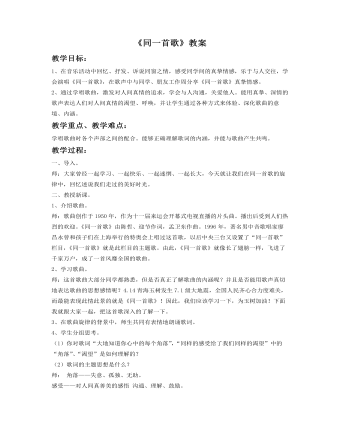
《同一首歌》教案
教学过程:一、导入。师:大家曾经一起学习、一起快乐、一起迷惘、一起长大,今天就让我们在同一首歌的旋律中,回忆述说我们走过的美好时光。二、教授新课。1、介绍歌曲。师:歌曲创作于1950年,作为十一届来运会开幕式电视直播的片头曲。播出后受到人们热烈的欢迎。《同一首歌》由陈哲、迎节作词,孟卫东作曲。1996年,著名男中音歌唱家廖昌永曾和孩子们在上海举行的特奥会上唱过这首歌,以后中央三台又设置了“同一首歌”栏目,《同一首歌》就是此栏目的主题歌。由此,《同一首歌》就像长了翅膀一样,飞进了千家万户,成了一首风靡全国的歌曲。2、学习歌曲。师:这首歌曲大部分同学都熟悉,但是否真正了解歌曲的内涵呢?并且是否能用歌声真切地表达歌曲的思想感情呢?4.14青海玉树发生7.1级大地震,全国人民齐心合力度难关,而最能表现此情此景的就是《同一首歌》!因此,我们应该学习一下,为玉树加油!下面我就跟大家一起,把这首歌深入的了解一下。3、在歌曲旋律的背景中,师生共同有表情地朗诵歌词。4、学生分组思考。(1)你对歌词“大地知道你心中的每个角落”,“同样的感受给了我们同样的渴望”中的“角落”、“渴望”是如何理解的?(2)歌词的主题思想是什么?师: 角落——失意、孤独、无助。感受——对人间真善美的感悟 沟通、理解、鼓励。
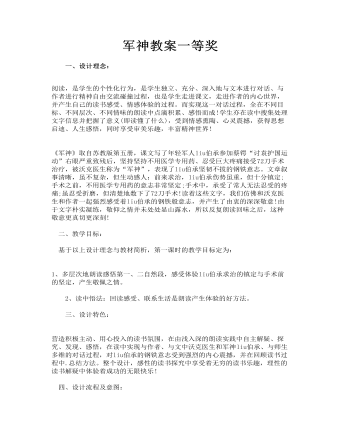
军神教案一等奖
二、教学目标: 基于以上设计理念与教材简析,第一课时的教学目标定为: 1、多层次地朗读感悟第一、二自然段,感受体验liu伯承求治的镇定与手术前的坚定,产生敬佩之情。 2、读中悟法:回读感受、联系生活是朗读产生体验的好方法。 三、设计特色: 营造积极主动、用心投入的读书氛围,在由浅入深的朗读实践中自主解疑、探究、发现、感悟,在读中实现与作者、与文中沃克医生和军神liu伯承、与师生多维的对话过程,对liu伯承的钢铁意志受到强烈的内心震撼,并在回顾读书过程中.总结方法。整个设计,感性的读书探究中享受着无穷的读书乐趣,理性的读书解疑中体验着成功的无限快乐!

《同一首歌》教案
A段由4个乐句构成,第一、二乐句(第1~8小节)音乐流畅、平和,主题深沉、亲切、凝重,第三乐句(第9~16小节)是这个乐段的小高潮,接着连接第四乐句结束。A段音乐抒发人们经过辛勤劳动获得丰硕成果、欢聚一堂亲切交流时的真挚感情。B段也由4个乐句构成,第一乐句(第17~20小节)以下属和弦的分解形式,从高音开始,造成柔和的色彩和热烈的气氛,力度逐渐加强的处理,形成全曲高潮,抒发了人们激动、兴奋的心情,并与A乐段形成对比。第二乐句(第21~24小节)是第一乐句的变化重复,使感情进一步深化,体现发自内心的倾诉。第三乐句(第25~28小节)是A段音乐主题的变化再现,第四乐句中的九度大跳,再次抒发出人们兴高采烈的喜悦心情。歌曲最后的结束句是一个典型的由下属功能转到主功能的补充终止形式,使歌曲在祥和、喜庆的气氛中结束。B段音乐揭示了歌曲的主题思想——我们向着建设社会主义现代化的伟大目标,唱着“同一首歌”去迎接新的辉煌。
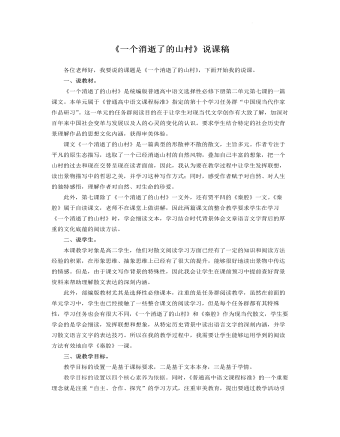
《一个消逝了的山村》说课稿 2021—2022学年统编版高中语文选择性必修下册
这几段内容传达出的是“要敬畏生命,尊重生命;更要敬畏大自然,尊重大自然,爱护大自然”的主旨内涵,因此让学生通过自由朗读的方式,再次体会冯至对这个消逝了的山村的细致的美好的描绘,感悟冯至传达出的对生命,对自然的理解和思考。5.最后一个自然段的解读依然是交给学生,先齐读课文,再让学生自主分享自己的体会或疑惑。但在这一环节我也设计了两个我认为必须解答的两个问题,一是怎么理解“在风雨如晦的时刻”;二是“意味不尽的关联”是指什么。我认为这两个问题一个涉及到写作背景,一个涉及到对全文主旨的一个整体把握,能够进一步帮助学生理解散文的深刻内涵和主旨,让学生有意识的在阅读散文过程中通过背景知识进行理解。既尊重学生的个性化解读,又能够让学生有意义学习,完成预设的教学目标。如果学生没有提到这两处,那我就需要做出补充。
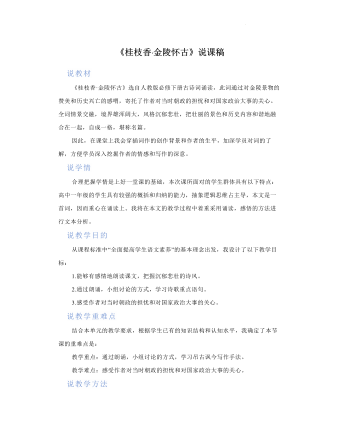
古诗词诵读《桂枝香?金陵怀古》说课稿(一) 2021-2022学年统编版高中语文必修下册
王安石,字介甫,号半山。北宋著名政治家、思想家、文学家、改革家,唐宋八大家之一。欧阳修称赞王安石:“翰林风月三千首,吏部文章二百年。老去自怜心尚在,后来谁与子争先。”传世文集有《王临川集》、《临川集拾遗》等。其诗文各体兼擅,词虽不多,但亦擅长,世人哄传之诗句莫过于《泊船瓜洲》中的“春风又绿江南岸,明月何时照我还。”且有名作《桂枝香》等。介绍之后设置这样的导入语:今天我们共同走进王安石,一起欣赏名作《桂枝香·金陵怀古》。(板书标题)(二)整体感知整体感知是赏析文章的前提,通过初读,可以使学生初步了解将要学到的基本内容,了解文章大意及思想意图,使学生对课文内容形成整体感知。首先,我会让学生根据课前预习,出声诵读课文,同时注意朗读的快慢、停顿、语调、轻重音等,然后再播放音频,纠正他们的读音与停顿。其次,我会引导学生谈谈他感受。学生通过朗读,能够说出本词雄壮、豪放、有气势,有对景物的赞美和对历史的感喟。
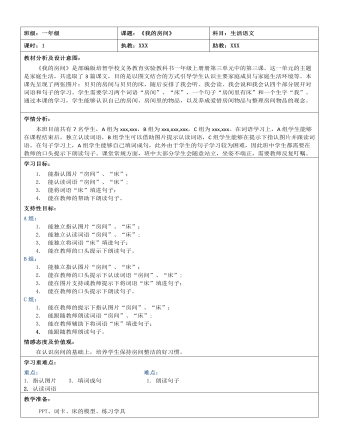
《我的房间》第一课时教案
一、情景导入,引出新知师:“上节课,奇奇妙妙邀请我们去参观了他们的家。这节课,又是哪个小朋友要邀请我们去参观他的家呢?”[出示xxx的照片]师:“这节课是xxx邀请我们去参观他的家。xxx,你要带我们去哪里看一看呢?”[PPT展示xxx家的阳台、房间和网络上的花园图片]<xxx指出自己的房间>师:“这节课,我们和xxx一起去参观房间。”[出示课题:10.我的房间]<学生跟读课题>二、循序渐进,程序教学(一)学习词语:房间[出示图片:房间]“xxx的房间是什么样子的?”“我们请xxx来介绍一下自己的房间。”(教师带领xxx说一说自己的房间有什么:大床、小床、电视)“这个有床、有电视,可以睡觉休息的地方就是房间。”[出示词卡:房间]
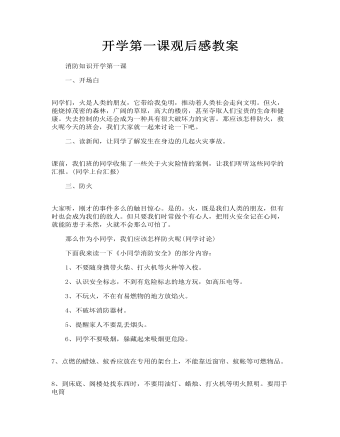
开学第一课观后感教案
三、防火 大家听,刚才的事件多么的触目惊心。是的。火,既是我们人类的朋友,但有时也会成为我们的敌人。但只要我们时常做个有心人,把用火安全记在心间,就能防患于未然,火就不会那么可怕了。 那么作为小同学,我们应该怎样防火呢(同学讨论) 下面我来读一下《小同学消防安全》的部分内容: 1、不要随身携带火柴、打火机等火种等入校。 2、认识安全标志,不到有危险标志的地方玩,如高压电等。 3、不玩火,不在有易燃物的地方放焰火。 4、不破坏消防器材。 5、提醒家人不要乱丢烟头。 6、同学不要吸烟,躲藏起来吸烟更危险。
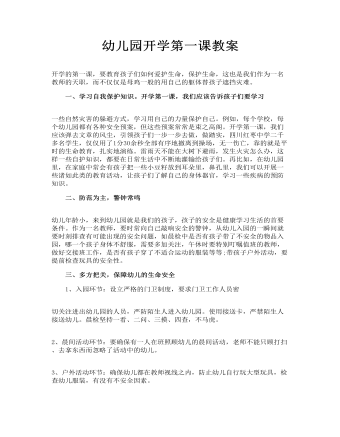
幼儿园开学第一课教案
二、防范为主,警钟常鸣 幼儿年龄小,来到幼儿园就是我们的孩子,孩子的安全是健康学习生活的首要条件。作为一名教师,要时常向自己敲响安全的警钟,从幼儿入园的一瞬间就要时刻排查有可能出现的安全问题,如晨检中是否有孩子带了不安全的物品入园,哪一个孩子身体不舒服,需要多加关注,午休时要特别叮嘱值班的教师,做好交接班工作,是否有孩子穿了不适合运动的服装等等;带孩子户外活动,要提前检查玩具的安全性。
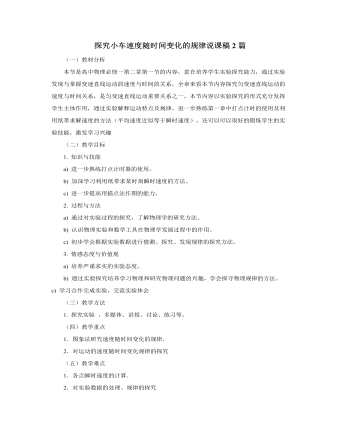
人教版新课标高中物理必修1探究小车速度随时间变化的规律说课稿2篇
(三)合作交流能力提升教师:刚才我们通过实验了解了小车的速度是怎样随时间变化的,但实验中有一定的误差,请同学们讨论并说出可能存在哪些误差,造成误差的原因是什么?(每个实验小组的同学之间进行热烈的讨论)学生:测量出现误差。因为点间距离太小,测量长度时容易产生误差。教师:如何减小这个误差呢?学生:如果测量较长的距离,误差应该小一些。教师:应该采取什么办法?学生:应该取几个点之间的距离作为一个测量长度。教师:好,这就是常用的取“计数点”的方法。我们应该在纸带上每隔几个计时点取作一个计数点,进行编号。分别标为:0、1、2、3……,测各计数点到“0”的距离。以减小测量误差。教师:还有补充吗?学生1:我在坐标系中描点画的图象只集中在坐标原定附近,两条图象没有明显的分开。学生2:描出的几个点不严格的分布在一条直线上,还能画直线吗?
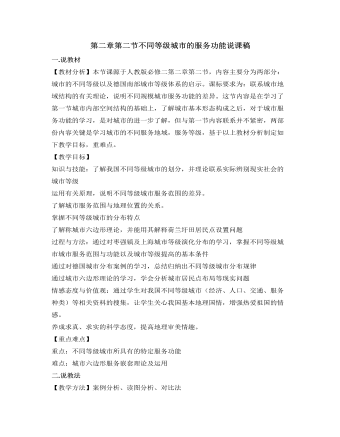
人教版高中地理必修2第二章第二节不同等级城市的服务功能说课稿
【教学目标】知识与技能:了解我国不同等级城市的划分,并理论联系实际辨别现实社会的城市等级运用有关原理,说明不同等级城市服务范围的差异。了解城市服务范围与地理位置的关系。掌握不同等级城市的分布特点了解称城市六边形理论,并能用其解释荷兰圩田居民点设置问题过程与方法:通过对枣强镇及上海城市等级演化分布的学习,掌握不同等级城市城市服务范围与功能以及城市等级提高的基本条件通过对德国城市分布案例的学习,总结归纳出不同等级城市分布规律通过城市六边形理论的学习,学会分析城市居民点布局等现实问题情感态度与价值观:通过学生对我国不同等级城市(经济、人口、交通、服务种类)等相关资料的搜集,让学生关心我国基本地理国情,增强热爱祖国的情感。养成求真、求实的科学态度,提高地理审美情趣。
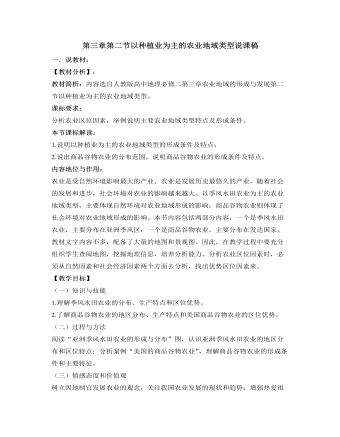
人教版高中地理必修2第三章第二节以种植业为主的农业地域类型说课稿
本节课标解读:1.说明以种植业为主的农业地域类型的形成条件及特点;2.说出商品谷物农业的分布范围,说明商品谷物农业的形成条件及特点。内容地位与作用:农业是受自然环境影响最大的产业。农业是发展历史最悠久的产业,随着社会的发展和进步,社会环境对农业的影响越来越大。以季风水田农业为主的农业地域类型,主要体现自然环境对农业地域形成的影响;商品谷物农业则体现了社会环境对农业地域形成的影响。本节内容包括两部分内容,一个是季风水田农业,主要分布在亚洲季风区;一个是商品谷物农业,主要分布在发达国家。教材文字内容不多,配备了大量的地图和景观图。因此,在教学过程中要充分组织学生查阅地图,挖掘地理信息,培养分析能力。分析农业区位因素时,必须从自然因素和社会经济因素两个方面去分析,找出优势区位因素来。
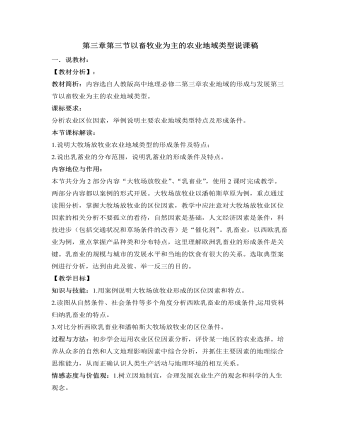
人教版高中地理必修2第三章第三节以畜牧业为主的农业地域类型说课稿
1.导入新课:通过视频“阿根廷的潘帕斯草原”,引起学生的兴趣,进而引出新的学习内容——以畜牧业为主的农业地域类型。2.新课讲授:第一课时,首先通过展示“世界大牧场放牧业分布图”,引出对大牧场放牧业的初步认识,了解其分布范围;然后通过展示“潘帕斯草原的地形图”“气候图”和“牧牛业景观图”,讨论分析大牧场放牧业形成的区位条件,并进行案例分析,学习该种农业的特点;最后,理论联系实际,展示:“中国地形图”“气候图”“人口图”“交通图”和“内蒙古牧区图”,分组讨论我国内蒙古地区能否采用潘帕斯草原大牧场放牧业的生产模式。第二课时,首先通过设问顺利从大牧场放牧业转入乳蓄业,通过讲述让学生了解乳蓄业的概念;然后通过展示世界乳畜业分布图,了解乳蓄业主要分布在哪些地区;接着,通过西欧乳蓄业的案例分析,得到乳蓄业发展的区位因素及其特点。
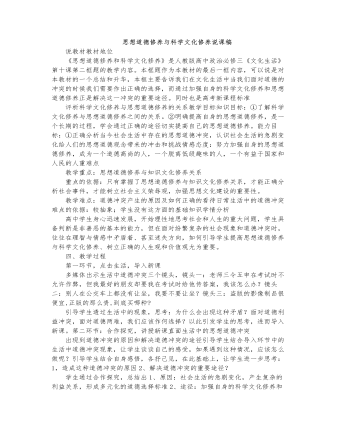
人教版高中政治必修3思想道德修养与科学文化修养说课稿
由此引导学生的深思,学生通过合作探究,帮助学生认识到不注重思想道德修养,即使掌握了丰富的科学知识,也难以避免人格上的缺失,甚至危害社会。进而总结出关系二:加强思想道德修养,能够促进科学文化修养。科学文化修养的意义播放感动中国人物徐本禹先进事迹短片。学生观看完视频后,思考:从徐本禹的事迹中,我们可以了解到我们加强科学文化修养的根本意义是什么?引导学生结合自身体会,发表各自见解,在此基础上帮助学生总结出,要使自己的思想道德境界不断升华,为人民服务的本领不断提高,成为一个真正有知识文化涵养的人,成为一个脱离低级趣味的人、有益于人民的人。知识点三:追求更高的思想道德目标根据教材110探究活动(思想道德的差异、反应人们世界观、人生观、价值观的差异)思考:用公民的基本道德规范来衡量这些观点,你赞成哪些观点?反对哪些观点?小组进行合作探究,引导学生根据公民基本道德规范对这些价值观进行评析。
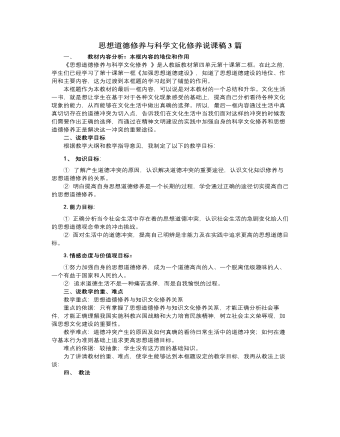
人教版高中政治必修3思想道德修养与科学文化修养说课稿3篇
(3)改造主观世界同改造客观世界的关系。改造客观世界同改造主观世界,是相互联系、相互作用的。改造主观世界是为了更好地改造客观世界,人们在改造客观世界的同时也改造着自己的主观世界。通过自觉改造主观世界,又能提高改造客观世界的能力。师:人们对自己的思想道德境界的追求,是永远止境的。让我们共同努力,在践行社会主义思想道德的过程中,不断追求更高的目标,像无数先辈那样,加入到为共产主义远大理想而奋斗的行列中吧!课堂小结通过本节课学习使我们认识到面对现实生活中的思想道德冲突,加强知识文化修养和思想道德修养,不断追求更高的思想道德目标的必要性;把握了知识文化修养与思想道德修养的含义及其相互关系;明确了我们应该和怎样追求更高的思想道德目标;认识到这是一个永无止境的过程。我们要脚踏实地,从现在做起、从点滴小事做起,不断提高知识文化修养和思想道德修养,追求更高的思想道德目标。
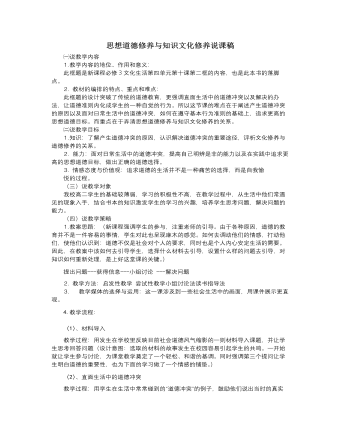
人教版高中政治必修3思想道德修养与知识文化修养说课稿
1.做学问之前首先学会做人2.知识文化修养和思想道德修养的关系三.追求更高的思想道德目标㈤ 说教学评价和反思:1.这节课主要是以学生为主体,老师为主导,让学生充分发表自己的看法,把理论的知识结合在实际的日常生活中,鼓励学生充分发表自己的意见,能调动学生学习的积极性,达到教学目的。这节课学生讨论,发言的机会很多,但由于我校的学生的基础薄弱,在发言时难免偏离老师引导的方向,甚至出现毫不相干的说法,由于本人经验不够此时如何去引导他们可能做的还不够好。2.新课程的教学,如何突破书本知识的局限,延伸更深层次的内容是一个难题。本节课在知识的处理上,把道德的重要性与道德的层次两个知识点补充了进去,目的是让学生在学习之前有一个情感的铺垫,从而更好地达到教学目标。





















